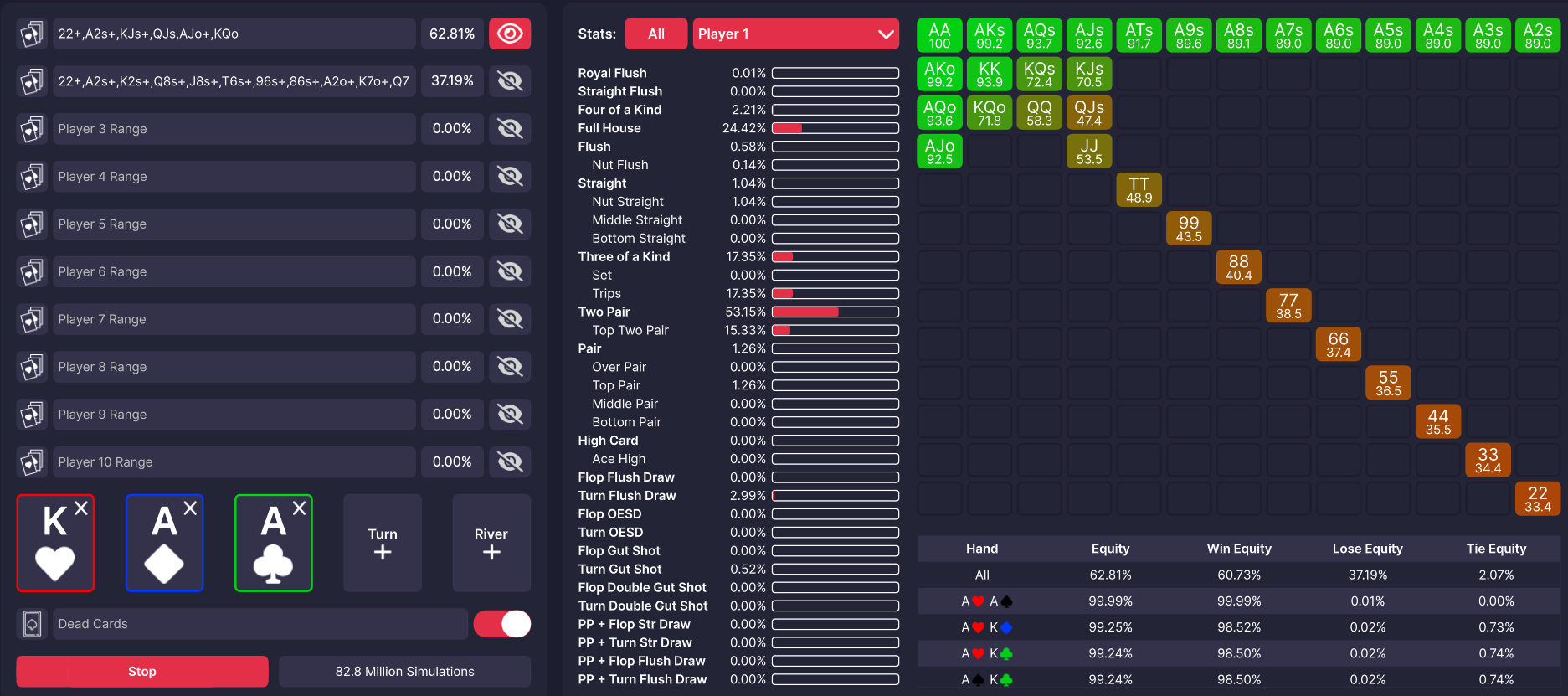Whilst hand reading is in an invaluable skill, so to is range and nut advantages. These concepts can help you manipulate pot sizes to your benefit and improve your profits in the long run. Its about understanding the context of pre-flop, likely hand selections in given spots and combining that with flop texture to intuitively grasp who the flop benefits. This is calculated instinctively by professional poker players but don’t worry, it will come naturally to you too in time.
In this blog post, I’m going to explain what range and nut advantages are so you can apply them at the table too.
What is Range Advantage?
Range advantage occurs when your potential holdings are stronger than your opponent’s holdings for a given situation. For example, preflop, the player who raises from early position has range advantage over the player who calls from the blinds. The raiser has many premium hands in their range like AK, AQ, JJ+ that the caller does not. So when a board comes that connects better with the preflop raiser’s range, like A-A-K rainbow, they maintain range advantage.
As shown in solver simulators, the preflop raiser often has around 60% equity on boards that favor their range, while the preflop caller has more weak and marginal holdings that lead to lower equity. Range advantage allows aggressive betting, as the player with the stronger potential holdings can represent many nut hands and draw possibilities their opponent struggles to continue against.
In the scenario above, we can see that early position has almost 63% equity and is therefore encouraged to bet heavily.

What is Nut Advantage?
Having the nut advantage means your range contains more of the strongest possible hands given the board texture. Using the example before, For example, your range is more likely to contain AK, AA, and KK – the current nut hands. Your opponent in the blinds has fewer nut hands like sets and strong two pairs since they just called preflop.
When you have this nut advantage, you can build large pots through aggressive betting because you are more apt to be ahead. Solvers recommend larger bet sizes and check-raises with nut hands to maximize value, even if you have less overall range equity. Your opponent is unlikely to continue without at least one pair or strong draw.
An example of nut advantage is UTG opening and the flop coming 4-4-2 rainbow. UTG has solid range advantage but not many 4’s in their range. The BB caller has more 4’s from flatting preflop. Despite usually being behind, BB will check-raise UTG some of the time to build a pot with their nut advantage. Having the best possible hand warrants betting bigger, regardless of your overall range strength.
So nut advantage focuses on the power of your strongest holdings, not just your entire range equity.
Does Range and Nut Advantage Matter?
As you develop your game and move up stakes, it certainly does. Competent players are looking at situations as “who’s range hits this flop more” and playing from there. They will manipulate pot sizes to suit their own agenda and punish opponents when they have their own range advantages. Expert players aren’t looking at short term decisions or results orientated ways of thinking. They’re like machines looking at the long term. So, understanding and applying range and nut advantage is crucial if you plan to play higher than NL$100.
If you play lower than this and don’t have goals to get there, then range advantages is less important and you can use this Texas Hold’em guide. You can certainly win without applying it and many opponents won’t care about textures or which flips hit who. Therefore, you don’t need to worry about it as much. However, I still think its worthwhile learning the concept as you can still apply it for your own gain.
Summary
To sum up, range advantage is where the flop texture favors your perceived range has greater equity than your opponents. Nut advantage is where someone has more nutted hands than their opponent regardless of the range advantage. Now you know both concepts, you can begin to apply them at the table. Just remember to use them in deeper stacked games as the range advantage strategy has less importance in short stacked games and SNGs.




